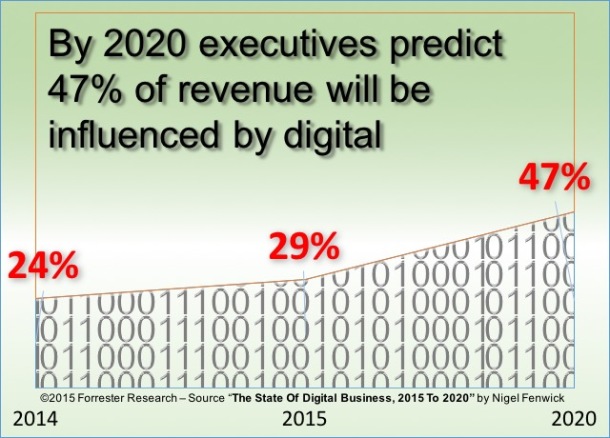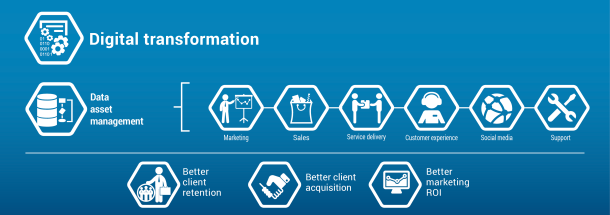I think we all have to acknowledge that the sales profession is going through a major transformation. Social media, mobile, and digital information means buyers are better informed and rely less on sales people in the purchasing journey. And that same purchase process has become longer and even more complex within the consultative type selling models.

Digital Sales Transformation could be defined as “How sales capabilities and competences need to be developed to address the “Connected Buyer”, meeting changes in the industry facilitated by digital tools”. In a nutshell, transforming sales performance will involve a combination of better training for the new age sales person, better use of technology/data, and better customer content to drive conversations.
It is not just another business buzzword to be bandied about at management meetings. The buyers journey is changing fast (wait till Millennials make up the majority of buyers!!) so it’s important to focus on real business and customer challenges and changes now. Now it the time to have a clear approach, prioritise action and involve the entire marketing and sales force in any digital transformation process. Where to focus in terms of market arenas (capture more business in the short term), what is the right offering (product to market fit) and value proposition for these markets, and how to manage customer relationships and sales to win in the digitally influenced market, are some of the questions to be answered.
The digital tools I mentioned above as part of the definition of sales transformation are invading the business ecosystem, bringing with them major changes in the way we work, communicate, and sell but most importantly the change in how customers buy. As with most things in like, this has brought both opportunities and challenges, and has triggered the Digital Transformation within companies for all aspects of customer touch points.
Sales enablement needs to focus on “value messaging”, “social selling” and “consultative selling” skills training.
The starting point is focused on improving the business awareness of the sales teams because the old sales methodology of selling product features to increasingly more sophisticated buyers will not cut the mustard. Sales professionals must be able to map the buyer’s journey, understand “Ideal Customer Profiles”, deliver compelling insights (using a variety of content) to differentiate themselves (Why me!!) And communicate this value to close more business without being dragged into the pricing discount race. So sales enablement leaders are looking to “value messaging”, “social selling” and “consultative selling” skills training using social networks to help the sales force communicate and influence buyer perceptions of value.
The development of these new sales or marketing competencies revolves around the capacities for sales people to be more agile, buyer-centred, innovative, connected, aligned and effective with present and future changes in mind. The digital sales transformation will have many connected goals, but in the end striving towards optimisation across sales processes, support divisions and the business ecosystem of the always-connected customer where building the right bridges with the right people at the right time during the buyers journey is the key to success.
A reminder of the buyer’s journey: Today’s buyers, from consumers looking for a new car to company buying committees purchasing software, can easily research and compare products thanks to the visibility offered up from a host of social networks.

The positive news is that with re-tuning for this digital era, sales teams have significant capabilities to impact the buyer’s journey to become a valuable influencer, aided by big data, digital selling tools, and organisational changes to the buyers’ growing level of self education.
The major themes of Digital Sales Transformation:
- Find growth in arenas before your competitors arrive
- Sell the way customers want to buy
- Optimise sales operations and digital tools
- Sales and marketing as a unified team who challenge the status quo and manage revenue performance
- Empowering sales enablement to make change happen
Look Ahead
The whole purpose of sales transformation is to drive profitable growth within companies. It is about using insights, social signals and data to anticipate buyer interests and map out where untapped potential lies. They focus on being useful and valuable to buyers in order to lock in new customers first (and out manoeuvre their competitors).
Find growth in Social Data
The use of social data as part of the sales engagement plan can open up amazing sales opportunities. Companies from all sectors, B2C and B2B can build insights from a wide array of internal and external sources and create tailored selling propositions based on prospect personalisation. However to maximise the benefits of social data, social selling needs to be at the very heart of the sales culture.
Selling that matches the Buyer’s Journey
Generation connected customers have discarded their participation in traditional sales models. They want self-determined, more seamless, and rewarding buying experiences; they want more of the right information at the right time, more value from sales interactions and they want on channels of their choosing. For sales leaders, getting their heads around this is hard enough but transforming sales models in mature or emerging markets is a major challenge. But leading sales organisations are finding ways to improve digital channels, the availability of content plus maximising direct and indirect channels. Using social data and social selling they are cracking the code of how to integrate them all. No company can win today using old sales methodologies, so the smart ones are using transformation to manage a multi-channel approach to ensure consistency, maintaining close contact with customers and raising the sales bar. The best sales leaders are transforming inside sales and field sales, integrating online with inbound with social selling, orchestrating direct and indirect sales and marketing teams and using data to drive activity.
The best test and tweak constantly to bring value to the buyer’s journey and turn conversations into sales conversions. They embrace social networks, mobile and understand the benefits of building deeper customer relationships across all platforms with quality content. Finally, they recognise that digital is an additive process, so they work hard at seamless integration with every other sales channel to win.
Mapping the Customer Decision Journey
“12% of all B2B sales in the US will take place online by 2020 – Forrester”

75% of purchases now start with an online search by the buyer. 90% of decision makers say that they never respond to cold outreach – (Harvard Business Review). More than half the sales process has disappeared. B2B buyers are 57% of the way through their purchasing decision before they ever engage a sales person. In fact, a B2B customer will regularly use different interaction channels throughout the purchase process. The mapping of Ideal Customer Profiles and the Customer Decision Journey around which marketing and sales collaborate has become standard practise in many progressive sales organisations. They also know that this journey is different by customer segment/profile, with varying needs and expectations at each point in the journey.
It is about ensuring the sales teams reaches the right people at the right time with the right offer.
Innovate Inside Sales
Cold calling is dying fast and some companies are still flogging dead horses. Sales transformation success can pivot on changing the inside sales approach. The leaders of the successful inside sales forces have recognised this. They use social selling to nurture customers early, long before any sales pitch. They seek to bring value and be a trusted source of information to unlock growth in key accounts which is the prerequisite for the consultative sale. Regardless of size or industry, there are always new ways for business development people to engage new customers.
Blend your Sales and Marketing Engine
In transforming the sales engine, business leaders must ensure that marketing and sales teams work together to extract the full value of every piece of data or customer touch point. Despite their co-dependency, it can seem like marketing and sales are marching to a different tune. Successful sales leaders work with marketing (and vice-versa), benefiting from the market insight skills it brings and feeding these insights to the sales engine to maximise every campaign or lead. Research has shown that when the two teams collaborate to drive sales and revenue, companies enjoy higher sales growth.
Use Technology as an Advantage in Sales
The use of digital sales tools must evolve to keep pace with customer preferences. Part of the role of sales enablement is to ensure the investment enables success instead being viewed as another big brother information tool. Appoint an owner whose focus is on acquiring and implementing the right tools to deliver the returns on productivity or performance the business expects.
Sales Transformation is about having the right Talent to Execute
Think “New Age Sellers”. Sales leaders can have all the social data, all the social selling training or all the digital tools available, but without having the talent who embrace this new progression, they will achieve little. Hard questions like do we have the right talent for our future sales plans or how many of our existing sales force can make the transformation we require have to be asked and answered.
Make Digital Selling Part of your Sales DNA
Sales transformation is not about achieving some short term wins but embedding it in to the genes of the organisation for the long term. The companies who will win out in selling to the always connected buyer will create a culture that embraces social channels. They will prioritise sales training and throw the spotlight onto people who are playing a starring role as agents of change, and they focus on social collaboration between sales, marketing and support that goes way beyond the individuals skills to create sales capabilities embedded into the DNA of the entire organisation
Growth will be driven from the Top
Every sales leader has to step forward and be at the forefront of change. Because without strong leadership any transformation initiative will hit the rocks sooner than you think! Strong leaders will be given the platform to challenge the status quo or “the way it’s always been done “thinking. They will galvanise their team, they plan and map change while demanding results from the sales force who has been equipped to win. Senior sponsorship and stakeholder alignment is critical as well as a clear vision of where to prioritise the transformation effort.
A final thought
Undertaking sales transformation may sound brave but the insights to future buyer preferences remove it as optional. The rise of social channels and data brings enormous opportunities for value creation and sales growth, but there are many challenges along the way. Any companies planning to be in business five years from now should already be preparing for a major overhaul of how they sell, no business and no industry is immune.
No comments:
Post a Comment